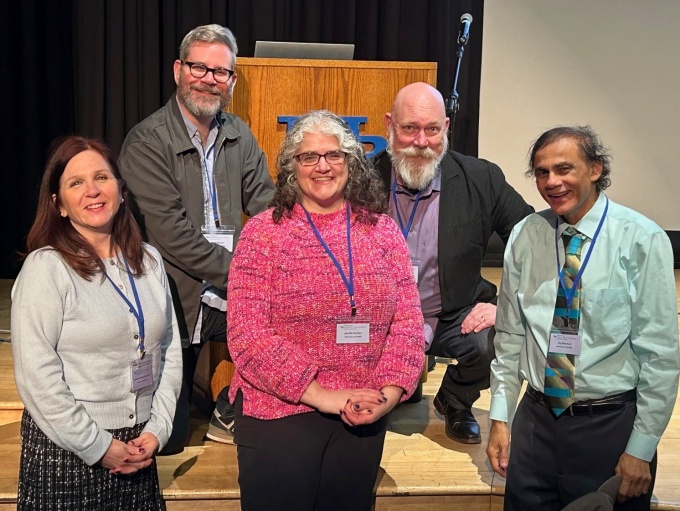CII Presentations at IAD Days (3/29/23)

Clockwise from top left: Matt Kenyon, Mark Shepard, Raj Sharman, Jennifer Surtees, and Laurene Tumiel-Berhalter
Work by CII members was featured during IAD Days, an annual event organized by the Institute for Aritificial Intelligence and Data Science (IAD) for their students. Projects featured were varied and highlighted the broad landscape for applications of AI and Data Science in the battle against mis/dis-information.
Detecting Misinformation in Online Healthcare Social Networks
Raj Sharman, Management Science and Systems, School of Management
Online Social Networks are rife with misinformation. Online healthcare social networks are no exception. Misinformation can impact patient safety when patients act on information that does not apply to them.
Given the nature of such forums, we study the influence of cohesive subgroups and the dynamics of thread conversation. Our findings show that the relative disease experience of the responders (compared to the person asking the thread question), question completeness, and clique membership influence response quality in a thread. Our findings also indicate that social network cues such as ‘likes’, while commonplace, are inaccurate indicators of response quality.
Sharman's presentation focussed on the work on Parkinson's disease. He emphasized the opportunities for use of ML and the need for understanding of disease progression and patient expeience in building models.
Looking for the Signature of Infection in Wastewater
Jennifer Surtees and Laurene Tumiel-Berhalter, Dept of Biochemistry at the Jacobs School of Medicine and Biomedical Science.
COVID-19 brought science to the forefront and uncovered public distrust of science. Conversely, called to "trust science" can take on pseudo-religious overtones rather than encouraging critical thinking.
Trust is down across the board; people distrust scientists, journalists, politicians, and each other. Building trust is important, not only for science, but for society. They then reviewed their current project that combines analysis of wastewater to trace mutations in the COVID-19 virus, big data analysis of the community to build models, and, importantly, community engagement to develop an early-warning system for the next pandemic and build trust in the community so the system will be effective.
Surtees gave and overview of the wastewater monitoring side of the project. Tumiel-Berhalter talked about the importance of community engagement. Both emphasized the importance of approaching trust building in terms of process. Community engagement is a process of developing a two-way conversation--not merely delivering information, but listening and learning from the community. Also important to introduce science itself as a process and helping people understand that process.
Tardigotchi: Embodied Artificial Life
Matt Kenyon, Department of Art
Kenyon reviewed some of his earlier works exploring the combination of technology and living systems.
Kenyon then introduced Tardigotchi, an award-winning interactive artwork that showcases two distinct pets - a living tardigrade and an artificial life avatar. Housed in a portable computing enclosure, this artwork blends biological and artificial life within a single interface.
One side of the object contains optics that make visible the biological "water bear" (named Steven) living inside in a bubble of water. The other side contains a small screne displaying the artificial life avatar, a caricature of the tardigrade. Steven is alive and mysterious. The avatar emotes in a way that is more readily understandable by humans. The avatar's behavior is partially autonomous, reflecting the tardigrade's daily activities. By interacting with the object, humans can provide food and warmth to both the living and artificial beings.
Tardigotchi playfully references the Tamagotchi toy from the 1990s, raising questions about the emotional attachment that can arise from simple interaction and whether biological life is essential for this attachment.
There Are No Facts: AI and Everyday Life
Mark Shepard, Departments of Media Study and Architecture
This talk examined the uncommon ground we share in a post-truth world. Shepard used the example of the architecture and technology involved in Amazon's foray into creating physical convenience stores. Amazon-Go provides a frictionless shopping experience based on extreme surveillance systems.
Shepard unpacked how attentive algorithms and extractive data practices are shaping space, influencing behavior, and colonizing everyday life. Articulating post-truth territory as an architectural and infrastructural condition, it shows how these spatial architectures of attention and data mining are in turn situated within broader histories of empiricism, objectivity, science, colonialism, and perception.